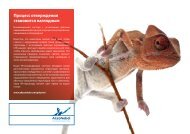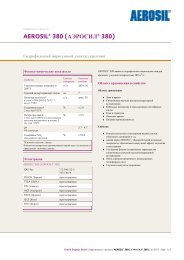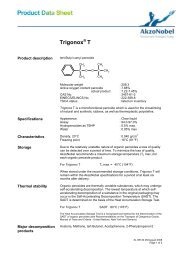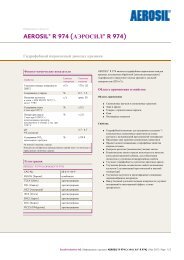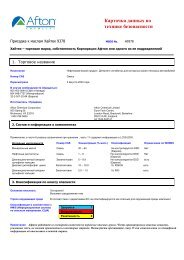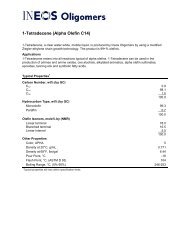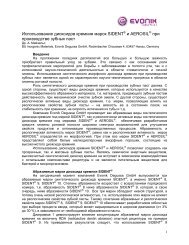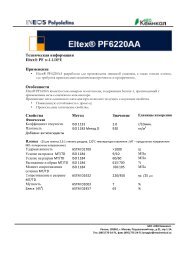ANTISOL™ FL Polyanionic Cellulose
ANTISOL™ FL Polyanionic Cellulose
ANTISOL™ FL Polyanionic Cellulose
You also want an ePaper? Increase the reach of your titles
YUMPU automatically turns print PDFs into web optimized ePapers that Google loves.
Water Base<br />
Drilling Fluids<br />
Drilling for Oil<br />
and Gas<br />
Product Bulletin<br />
ANTISOL <strong>FL</strong> <strong>Polyanionic</strong> <strong>Cellulose</strong><br />
Drilling Fluids Product Range<br />
In order to understand the use of products to overcome problems encountered in deep<br />
well drilling, it is necessary to appreciate the function and properties of drilling fluids.<br />
These are essential parts of the rotary drilling system.<br />
Basically, these fluids insure a high rate of penetration and a good bore hole stability.<br />
The fluid is pumped down the drill pipe and returns to the surface via the annulus loaded<br />
with solids. Rock particles and other solid or semisolid matters are removed by sieves and<br />
centrifuges. Then the drilling fluid is pumped back to the holding tank for recirculation. This<br />
is the method that is preferred in deep well drilling.<br />
Originally water alone was used but it was soon observed that the clay picked up during<br />
drilling gave muds with better flow properties and a higher debris carrying capacity.<br />
However, these properties varied tremendously according to the geological structure<br />
making control of the mud almost impossible. This type of mud was also very susceptible<br />
to contamination and precipitation by salts from the drilling strata, necessitating the use of<br />
excessive quantities of mud and adjustment of properties.<br />
To overcome the disadvantages of these random clay and water systems special polymer<br />
containing suspensions were developed. It can be stated that with the use of polymers –<br />
like ANTISOL <strong>FL</strong> <strong>Polyanionic</strong> <strong>Cellulose</strong> - the properties of drilling fluids can be adapted to<br />
the highly differing demands resulting from the formation encountered during drilling.<br />
®TM Trademark of The Dow Chemical Company (“Dow”) or an affiliated company of Dow<br />
Page 1 of 4 ANTISOL <strong>FL</strong> Polymers/Dow Oil & Gas Form No. XXX-XXXXX-0710
Composition of<br />
Water Based<br />
Drilling Fluids<br />
Functions of<br />
Drilling Fluids<br />
PAC versus CMC<br />
polymer<br />
Product Range for Drilling Fluids<br />
Type<br />
<strong>Polyanionic</strong> <strong>Cellulose</strong><br />
Water based drilling fluids can be formulated either with or without clay. For the reduction<br />
of fluid loss, clay constitutes an essential basis for drilling fluids. Polymers are needed to<br />
adjust predetermined, specified values resulting from the formation. These polymers<br />
perform the following essential functions:<br />
• An effective clay dispersion particle as a result of the polymer adsorption on the<br />
surface of the clay platelets. Thus more favourable values with respect to fluid loss are<br />
achieved.<br />
• A protection of the clay platelets against the detrimental effects of electrolytes.<br />
• A "free" water retention of the drilling fluid which could penetrate into the formation.<br />
• Shale inhibition that prevents the swelling of shale formations and the dispersion of the<br />
shale in the drilling fluid.<br />
For special uses other chemicals can be added to the drilling fluid system based on water,<br />
clay and polymers. These products can be, for example, thinners, lubricants, defoamers,<br />
etc.<br />
Drilling fluids have the following essential functions:<br />
• removal of cuttings<br />
• stabilization of the bore hole<br />
• cooling and lubrication<br />
• control of formation pressure<br />
These requirements can be responded by drilling fluids formulated thanks to polymers with<br />
suspension capability (i.e. viscosification), filtrate loss control to the formation, clay<br />
stabilization, and lubrication.<br />
Sodium carboxymethyl cellulose (CMC) is an unpurified anionic polymer containing up to<br />
40% salts (sodium chloride and sodium glycolate) which has been discovered to answer<br />
the above needs. Unfortunately nowadays, industry requirements have shown that the<br />
ordinary CMC polymer has limitations in salt solutions which lead the drilling industry to call<br />
for a specifically designed polymer, the polyanionic cellulose (PAC).<br />
Dow Wolff Cellulosics has been leveraging its manufacturing expertise in serving the highly<br />
demanding regulated markets, such a food, pharmaceuticals and dental care, to offer the<br />
premium PAC grades ANTISOL <strong>FL</strong> Polymers. These viscosify high electrolyte containing<br />
systems besides having outstanding filtration reduction and clay stabilising properties.<br />
They are a very versatile additive for various applications; the range of use concentration is<br />
consequently broad, from 0.2 to 5 lb/bbl (0.6 to 14 kg/m 3 ).<br />
The medium viscosity grade ANTISOL <strong>FL</strong>100 is used in common solids content muds. The<br />
low viscosity grades ANTISOL <strong>FL</strong>30 and <strong>FL</strong>10 are used to reduce fluid loss in heavily<br />
weighted muds, where commonly xanthan polymers are used as suspending agents.<br />
Active content<br />
(min %) 1<br />
Brookfield viscosity<br />
LVT / 25°C (mPa.s)<br />
ANTISOL <strong>FL</strong> 30 000 98 Min 2500 1<br />
ANTISOL <strong>FL</strong> 100 98 80 – 160 2<br />
ANTISOL <strong>FL</strong> 30 98 20 – 60 2<br />
They are not to be considered product specifications<br />
1. Not conering the humidity as packaged.<br />
Concentration of solutiuon<br />
for viscosity (%)<br />
Page 2 of 4 ®TM Trademark of The Dow Chemical Company (“Dow”) or an affiliated company of Dow Form No. XXX-XXXXX-0710
Product<br />
Properties<br />
ANTISOL <strong>FL</strong> 30 000 Extremely high viscosity<br />
• A fluid loss agent with a very high yield<br />
• An excellent viscosifier<br />
• With shale inhibiting properties<br />
ANTISOL <strong>FL</strong> 100 Low viscosity<br />
• A fluid loss agent with a good yield and also extremely good rheological<br />
properties for low filtrate values<br />
ANTISOL <strong>FL</strong> 30 Ultra Low Viscosity (ULV)<br />
Shipping Data,<br />
Storage and<br />
Handling<br />
Product<br />
Stewardship<br />
• A fluid loss agent for extremely low filtration values<br />
• No disturbing increase in viscosity<br />
ANTISOL <strong>FL</strong> PAC Polymer is shipped in 25-kg paper bags, palletized to 750 kg (30<br />
bags) or 1000 kg (40 bags) for 20-feet container shipments of respectively 15 or 10 tones.<br />
When the product is handled in a closed system, the possibility exists that the<br />
concentration of dust could build up to such a degree that a dust explosion could occur.<br />
This fact should he considered in designing handling systems, such as bulk storage bins,<br />
pneumatic conveyors, and the like. In open handling systems, this hazard is negligible.<br />
Dow encourages its customers and potential users of the Dow Oil & Gas products and<br />
materials to review their applications from the standpoint of human health and<br />
environmental aspects. To help ensure that it is not used in ways for which it is not<br />
intended or tested, Dow personnel will assist customers in dealing with environmental and<br />
product safety considerations. Dow literature, including Safety Data Sheets, should be<br />
consulted prior to the use of the Dow Oil & Gas products and materials. Please refer to the<br />
resources on the website www.dow.com or contact the Online Technical Support thereon.<br />
®TM Trademark of The Dow Chemical Company (“Dow”) or an affiliated company of Dow<br />
Page 3 of 4 ANTISOL <strong>FL</strong> Polymers/Dow Oil & Gas Form No. XXX-XXXXX-0710
Obtaining a Sample For literature or samples, feel free to call our Customer Information Group:<br />
Europe toll free number: +800 3 694 6367 †<br />
telephone: +32 3 450 2240 fax: +32 3 450 2815<br />
North America toll free number: 800 447 4369<br />
phone: +1 989 832 1556 fax: +1 989 832 1465<br />
Latin America phone: +55 11 5188 9222 fax: +55 11 5188 9749<br />
Asia-Pacific toll free phone +500 7776 7776*<br />
phone: +60 3 7958 3392 fax: +60 7958 5598<br />
Email to: dowcig@dow.com<br />
Complementary<br />
Product Offering<br />
Contact information goes here:<br />
North America: 1-800-477-4369<br />
Europe: (+32) 3-450-2240<br />
Asia/Pacific: (+852) 2879 7339<br />
Other areas: 1-989-832-1556<br />
http:// www.dowoilandgas.com<br />
Published July 2010<br />
† International toll free from Austria, Belgium, Denmark, Finland (prefix 990), France, Germany, Hungary, Ireland, The<br />
Netherlands, Norway, Portugal, Spain, Sweden, Switzerland, and the United Kingdom.<br />
* Toll free service not available in all countries<br />
To serve your oil field needs, Dow Oil & Gas also offers other polymers such as<br />
CELLOSIZE HEC.<br />
Also broad spectrums of chemicals and materials for drilling, stimulation and cementing<br />
operations, for use in oil and gas production and to enhance oil recovery are available.<br />
Please refer to the corresponding technical application sheets.<br />
Notice: No freedom from any patent owned by Dow or others is to be inferred. Because use conditions and applicable laws<br />
may differ from one location to another and may change with time, Customer is responsible for determining whether products<br />
and the information in this document are appropriate for Customer's use and for ensuring that Customer's workplace and<br />
disposal practices are in compliance with applicable laws and other government enactments. The product shown in this<br />
literature may not be available for sale and/or available in all geographies where Dow is represented. The claims made may<br />
not have been approved for use in all countries. Dow assumes no obligation or liability for the information in this document.<br />
NO WARRANTIES ARE GIVEN; ALL IMPLIED WARRANTIES OF MERCHANTABILITY OR FITNESS FOR A PARTICULAR<br />
PURPOSE ARE EXPRESSLY EXCLUDED.<br />
Page 4 of 4 ® Trademark of The Dow Chemical Company (“Dow”) or an affiliated company of Dow Form No. XXX-XXXXX-0710



